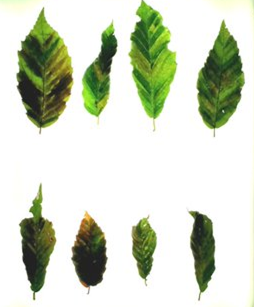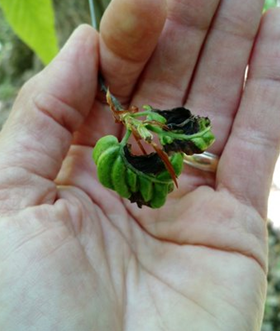
Beech Leaf Disease

Beech Leaf Disease (BLD) is a newly described disease affecting American, Chinese, European and Oriental beech trees in the United States and Canada. In 2012, the symptoms of Beech Leaf Disease were first observed by John Pogacnik of Lake Metroparks in American beech (Fagus grandifolia) trees in Lake County, Ohio. This new disease complex is associated with a newly discovered nematode, Litylenchus crenatae mccannii. The nematode causes damage to newly forming leaves inside beech tree leaf buds during the winter. After emerging in the spring, the damaged leaves lead to reduced tree vigor and can eventually lead to tree mortality.
People are encouraged to download the Tree Health Survey app to report both diseased and healthy American Beech trees. See the Tree Health Survey Manual for help in using the app. Park users are encouraged to report suspect trees with signs or symptoms of BLD to their local park managers and/or to the ODNR Forest Health Program Administrator Thomas Macy, thomas.macy@dnr.state.oh.us 613-265-6705.
For a downloadable summary please click here: USDA Forest Service Pest Alert – BLF
Hikers should clean their boots to prevent the spread of invasive species. People should not move beech firewood or plant material, including live or dead leaves and branches with buds. It is most important to not move plant material within or out of known infected areas. Nematodes can overwinter in healthy leaves and buds, within leaf litter in the forest floor and within dormant buds. Nematodes may be present in small numbers within leaf and bud tissue even if visible symptoms of the disease are not evident.
Biology
The cause of serious tree decline and death associated with Beech Leaf Disease is not yet completely understood, and research is ongoing. Researchers at the Holden Arboretum, the United States Department of Agriculture (USDA), and the Ontario Forest Research Institute have revealed a strong association between BLD symptoms and the presence of the nematode Litylenchus crenatae mccannii in the buds of beech trees. Experiments using extracts of live nematodes injected into dormant buds resulted in development of BLD symptoms upon leaf emergence. Live nematodes are capable of inducing symptoms with as little as a 2-week incubation period once injected into dormant buds. The possible role of other organisms, such as bacteria, in development of BLD is still being investigated.
Where it’s from
Nematodes are microscopic animals also known as roundworms. They are a diverse group that inhabit many different kinds of environments and some act as pathogens of plants and animals. Litylenchus crenatae is a species of nematode originally described and isolated from Japanese beech trees (Fagus crenatae) in Japan. Litylenchus crenatae mccannii appears to be a subspecies of a nematode that now occurs in parts of North America. Unlike the potentially deadly BLD nematode subspecies found in Canada and the US, the Japanese nematode does not appear to cause tree mortality in Japanese beech trees. Other species of nematodes cause non-lethal diseases on trees in other countries around the world.
How it spreads
The disease appears to spread through beech forests, but there is no agreement yet on how the nematodes move from one cluster of trees to another. Live nematodes and nematode eggs can overwinter in beech leaf buds, and the nematodes have been found in detached beech leaves on the ground after leaf fall in autumn. Once established within the tree, nematodes may maintain their population by moving from leaves to buds in autumn prior to leaf fall. Nematodes then overwinter in dormant buds, causing tissue damage prior to leaf emergence in spring. How nematodes move between forests, or infest new forested areas is still uncertain but the nematodes that cause BLD might be spread by birds, mites, or other insects. Nematodes may be present in low levels in leaves that do not show visible symptoms of BLD. More research is needed to understand the relationship between nematode population size and BLD symptom development. Long range spread among countries and states may be due to the transporting of infected nursery stock.
Where it’s found
Beech Leaf Disease has spread rapidly since 2012, and is now found in sixteen counties in Ohio, and seven states including: Pennsylvania, Connecticut, New Jersey, Rhode Island, New York (including Long Island), Massachusetts, West Virginia, as well as in Ontario, Canada.

What’s being done
Research is underway to determine the relationships between BLD symptoms and fungal and bacterial communities on plant leaves. Although infestation of leaves by Litylenchus crenatae mccannii appears required for BLD, fungi or bacteria could play a role in symptom development, and symptom progression leading to leaf mortality (Burke et al. 2020, Carta et al. 2020, Reed et al. 2020). Current research is also underway to determine the level of nematodes needed for symptoms of BLD to become apparent. Field testing of various pesticides is also underway to elevate possible control mechanisms for BLD within landscape settings and for specimen trees.

Surveys are being conducted across Ohio to determine if BLD is present within the county, with a goal of surveying at least ten sites per county (Dan Volk, 2021). As of March 2021, half of Ohio’s counties have had at least one survey for BLD conducted. The Cleveland Metroparks recommends several high priority counties to be surveyed in 2021. If your organization can assist with these surveys, please download and use the Tree Health Survey app or contact Dan Volk of the Cleveland Metroparks. These counties are either adjacent to counties with BLD or were recently discovered to have BLD but have had minimal surveys over the last two years, and include:
- Ashland
- Carroll
- Columbiana
- Erie
- Holmes
- Huron
- Jefferson
- Knox
- Richland
- Sandusky
- Tuscarawas
On Cleveland Metroparks publications page you can find links to all their Beech Leaf Disease webinars.
Images of Beech Leaf Disease




Older infestations of BLD



Who to contact
Reporting BLD:
- ODNR Forest Health Program Administrator Thomas Macy, thomas.macy@dnr.state.oh.us 613-265-6705
Management options for:
Homeowners –
People are encouraged to download the Tree Health Survey app to report both diseased and healthy American Beech trees. See the Tree Health Survey Manual for help in using the app. Trees can also be reported to the ODNR Forest Health Program Administrator Thomas Macy, thomas.macy@dnr.state.oh.us 613-265-6705.
People should not move beech firewood or loose plant material, including live or dead leaves and branches with buds. Pruned or dead material should be disposed of in lawn waste bags. It is most important to not move loose plant material within or out of known infected areas.
Pruning off infected leaves and branches can help reduce the number of nematodes present in your tree but should be properly disposed of in a lawn waste bag. For a more aggressive treatment, application of pesticides may be useful with proper usage, but official recommendations have not been announced.
Sources
Burke, David J.; Hoke, Adam J.; Koch, Jennifer. 2020. The emergence of beech leaf disease in Ohio: Probing the plant microbiome in search of the cause. Forest Pathology. 50(2): e12579. 12 p. https://doi.org/10.1111/efp.12579 https://www.fs.usda.gov/treesearch/pubs/59914
Carta, Lynn Kay; Handoo, Zafar A.; Li, Shiguang; Kantor, Mihail; Bauchan, Gary; McCann, David; Gabriel, Colette K.; Yu, Qing; Reed, Sharon; Koch, Jennifer; Martin, Danielle; Burke, David J. 2020. Beech leaf disease symptoms caused by newly recognized nematode subspecies Litylenchus crenatae mccannii (Anguinata) described from Fagus grandifolia in North America. Forest Pathology. 50(2): e12580. 15 p. https://doi.org/10.1111/efp.12580. https://www.fs.usda.gov/treesearch/pubs/59915
Reed, Sharon E.; Greifenhagen, Sylvia; Yu, Qing; Hoke, Adam; Burke, David J.; Carta, Lynn K.; Handoo, Zafar A.; Kantor, Mihail R.; Koch, Jennifer. 2020. Foliar nematode, Litylenchus crenatae ssp. mccannii, population dynamics in leaves and buds of beech leaf disease-affected trees in Canada and the US. Forest Pathology. 50(3): e12599. 9 p. https://doi.org/10.1111/efp.12599. https://www.fs.usda.gov/treesearch/pubs/60749